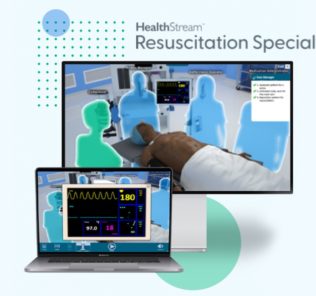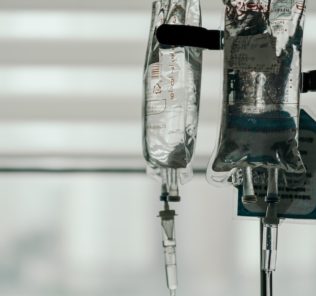Design, Implementation & Evaluation of Point-of-Care Simulation Training Project
Healthcare simulation education and training have forever changed the potential for clinical experiences to prepare learners for real-world scenarios. In addition to enhancing clinician preparedness, medical simulation has helped improve patient safety and empower learners and staff. Using this practice to improve acute illness recognition and management in a community hospital setting, a team of facilitators from the Cornwall Partnership NHS Foundation Trust sought to develop a point-of-care simulation program that was replicable and transferable and, if successful, could be rolled out across all wards and departments in the trust. This article discusses their research and the project’s point-of-care simulation aims, objectives, approach, and results.
Published in Nursing Times, the team released the article “Using point-of-care simulation to better manage acute deterioration,” and begin by sharing how point-of-care or in-situ, clinical simulation allows multidisciplinary teams to train together in their usual patient care environment. The article adds that learning in familiar teams and environments gives some advantages over traditional simulation training. For example, they found that point-of-care simulation can improve staff morale and enhance education at the coalface. Further, they found that the “key” was ensuring staff used their own knowledge, resources, and equipment while running the simulation in real-time.
Thus, the aims of the point-of-care simulation project became to review and improve clinical practice around the recognition of deterioration, and the [rovision of treatment for medical emergencies (including sepsis and hypoglycemia). Another aim was to review and improve the management of a patient in cardiac arrest. Objectives included assessing clinical practice around the recognition of patient deterioration, treatment of sepsis or hypoglycemia, and management of a patient in cardiac arrest.
Sponsored Content:
To implement this project, researchers used a plan, do, study, act (PDSA) cycle. According to the authors, this was chosen for its pragmatic methodology and longevity of effectiveness in implementing change and helping teams to improve quality of care. Led by Kim Clotworthy, this project was then planned in three phases: Sepsis, severe hypoglycemia, and cardiac arrest. Here are how the phases were broken down:
Phase I: Three simulation scenarios were delivered with no advance warning or additional training; during each one, staff performance was assessed using one agreed performance criteria tool for hypoglycemia and sepsis, and another for cardiac arrest. Staff was graded on whether they met the assessment criteria fully, partly, or not at all for each of the domains.
Phase II: Phase two involved evaluating the results from phase one and implementing safety actions and bespoke training where needed.
Phase III: The next step was to deliver identical simulations using the same assessment tool to evaluate performance. However, on the first hospital site, this was only possible for hypoglycemia and sepsis, as clinical and organizational challenges prevented us from running simulations for cardiac arrest. Due to Covid-19, we were also unable to run phase three at the second hospital site.
Sponsored Content:
The project was delivered in ward-based teams across two hospitals at separate times over one year. A 20-bed ward at one hospital was used to test the model. Amendments were made after review, and then clinical simulation was delivered on two wards at the second hospital. Further, an advanced healthcare simulation manikin with high-fidelity functions was used and patient simulation scenarios were developed. To measure potential improvements, three assessment tools were devised:
- Pre- and post-project staff knowledge and confidence surveys.
- Point-of-care simulation assessment of staff performance – skills, knowledge, team working/human factors.
- Post-simulation feedback.
From the pre-and post-project staff confidence surveys, researchers were able to analyze staff perception of their own knowledge and confidence regarding elements of managing a deteriorating patient. They could also assess staff participation in managing a cardiac arrest. Staff was also asked to provide formal feedback after every clinical simulation session. The authors explain that the feedback was based around six questions focused on: the value of the point-of-care simulation working experience, improving staff confidence and ability, and modifying practices.
Ultimately, this project assessed skills delivered tailored educational content and re-evaluated learning. The project also enabled the implementation of organizational safety changes, and improved staff knowledge and confidence in recognizing and managing a deteriorating patient. There were 107 participants in total involved in 31 simulations, comprising nurses (32%), healthcare assistants (38%), doctors (5%), nursing students (18%), and others (7%). Delivery of training at the point of care enabled the different professions to train and learn together.
The research team emphasized that they were able to show that point-of-care simulation training has several advantages, including providing experiential learning opportunities that facilitate interprofessional experiences. According to the article, this fits with the vision of the NHS’s (2014) Five Year Forward View for services to be integrated around the patient journey and involve multidisciplinary team working. Thus, researchers note that point-of-care simulation can have two key advantages:
- Enhancing the development of community hospital inpatient staff knowledge, skills, and confidence.
- Increasing multidisciplinary working and collaboration.
Overall, this research project showed that point-of-care simulation can be used to update staff knowledge, and improve their ability and confidence in acute illness management. The team’s research demonstrated that point-of-care simulation gave staff greater self-assurance in dealing with emergency events while encouraging multidisciplinary team integration, interprofessional learning, and effective care delivery. Point-of-care simulation can therefore be considered an innovative training tool that is “very well received by staff as a mode of learning, as shown by [the research team’s] qualitative and quantitative project evaluation feedback data.”
Moving forward, the authors intend to build on the project’s success by creating and embedding a sustainable point-of-care simulation program trust-wide. They say this could then be replicated by other organizations developing training in acute illness recognition and management.
Read Full Point-of-Care Clinical Simulation Research Article
Reference:
Clotworthy K et al (2021) Using point-of-care simulation to better manage acute deterioration. Nursing Times [online]; 117: 12, 39-43.
Lance Baily, BA, EMT-B, is the Founder / CEO of HealthySimulation.com, which he started in 2010 while serving as the Director of the Nevada System of Higher Education’s Clinical Simulation Center of Las Vegas. Lance also founded SimGHOSTS.org, the world’s only non-profit organization dedicated to supporting professionals operating healthcare simulation technologies. His co-edited Book: “Comprehensive Healthcare Simulation: Operations, Technology, and Innovative Practice” is cited as a key source for professional certification in the industry. Lance’s background also includes serving as a Simulation Technology Specialist for the LA Community College District, EMS fire fighting, Hollywood movie production, rescue diving, and global travel. He and his wife live with their two brilliant daughters and one crazy dachshund in Las Vegas, Nevada.
Sponsored Content:


















